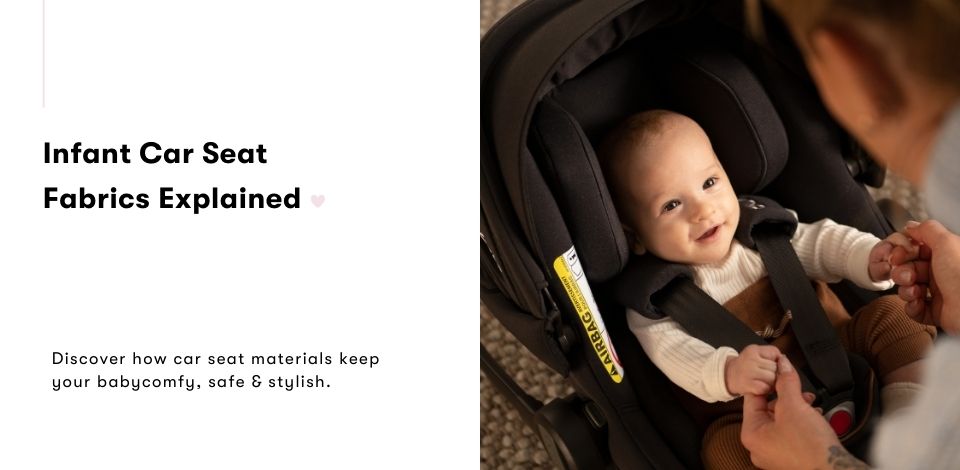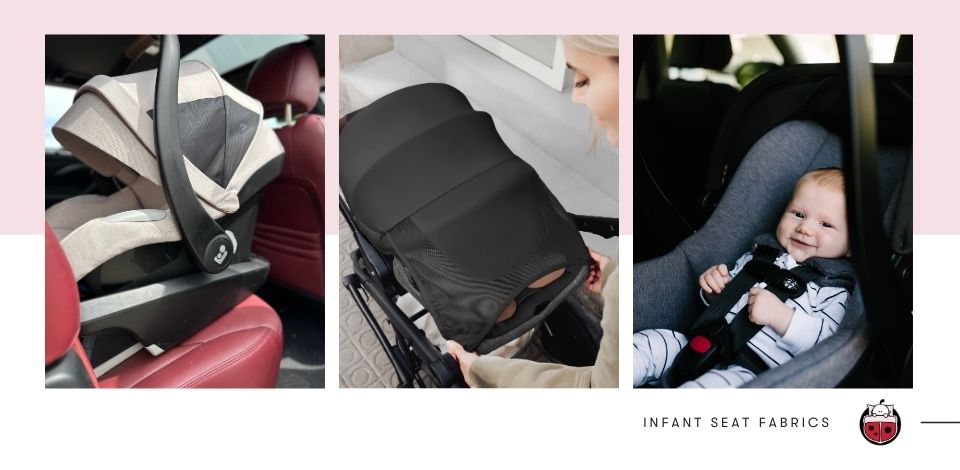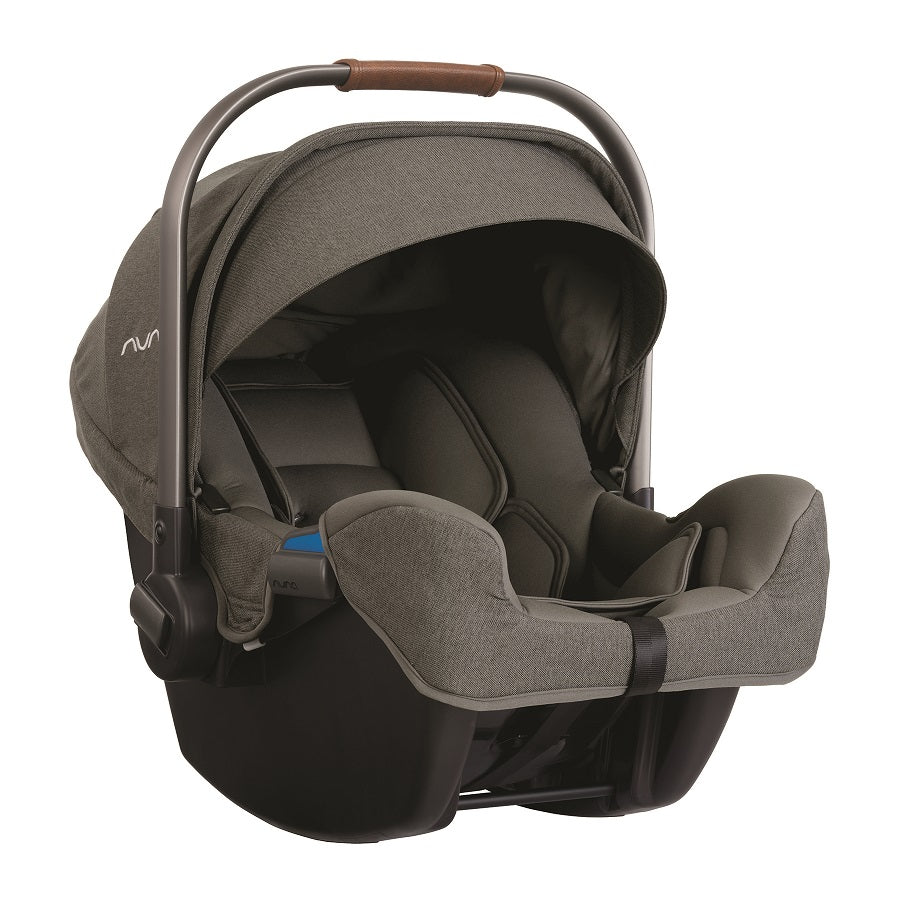Infant Car Seat Fabrics Explained
Jump to Section

When you’re shopping for an infant car seat, you’ll naturally focus on safety features first, things like installation, side-impact protection, and harness design. But once you start comparing seats, you’ll quickly realize there’s another important factor to consider: the fabric.
Infant car seat fabrics aren’t just about looks (though we love a stylish canopy). They play a big role in your baby’s comfort, safety, and even your peace of mind as a parent. From eco-friendly materials to moisture-wicking textiles, knowing what to look for can help you make a confident choice.
Let’s break down the most common car seat fabrics, what they mean for you and your baby, and why they matter in everyday use.
Why Fabrics Matter in Infant Car Seats
Your little one will spend a lot of time in their car seat from quick errands to long road trips and naps on the go. The fabric against their delicate skin should be:
- Soft and breathable for comfort
- Durable and easy to clean for inevitable spills and messes
- Safe and non-toxic (free from harmful chemicals and added flame retardants)
- Temperature-regulating so baby stays cozy in winter and cool in summer
- Choosing the right fabric can make all the difference in whether your baby feels snug and happy… or sweaty and fussy 10 minutes into the drive.
Common Fabric Types in Infant Car Seats
Here’s a breakdown of the fabrics you’ll most often see across premium infant car seats in Canada:
1. Standard Polyester Fabrics
Most infant car seats use a polyester-based fabric blend. These materials are durable, fade-resistant, and relatively easy to clean. They often feature extra padding for comfort and are tested for breathability.
- Pros: Affordable, durable, wide range of colours/styles.
- Considerations: May not regulate temperature as well as natural fibres.
2. Moisture-Wicking Fabrics
Some seats offer upgraded fabrics designed to wick away sweat and moisture. This is especially helpful if you live in a warmer climate or plan on summer road trips. These fabrics keep the baby cool and reduce fussiness.
- Pros: Keeps baby drier and cooler, more comfortable for long rides.
- Considerations: Often found on higher-end models only.
3. Merino Wool Blends
Merino wool is a luxury, natural fabric that’s popping up in many premium infant seats (hello, Nuna and Clek). Known for its softness, it’s also naturally flame resistant, meaning it doesn’t need added chemical flame retardants. It regulates temperature beautifully, keeping your little one warm in the winter and cool in the summer.
- Pros: Ultra-soft, breathable, moisture-wicking, naturally flame-resistant, eco-friendly.
- Considerations: Typically adds to the price tag.
4. Eco-Friendly & Sustainable Fabrics
Brands like Romer (Seawool) and Clek (Mammoth Collection) use sustainable fabrics made from recycled or natural materials. These options appeal to eco-conscious families looking to reduce their footprint while still prioritizing safety and comfort.
- Pros: Sustainable, breathable, often hypoallergenic.
- Considerations: Limited availability; sometimes more expensive.
5. Mesh Panels & Breathable Inserts
Some seats (like the Nuna PIPA series and Maxi-Cosi Mico Luxe+) incorporate mesh ventilation panels in the canopy or seat body. These boost airflow and help prevent overheating, especially useful during Canadian summers when cars heat up quickly.
- Pros: Improves airflow, reduces sweating.
- Considerations: Not full-fabric coverage, more of a design add-on.
Flame Retardant-Free Fabrics
This is a big one. Many parents today want fabrics that are free from added chemical flame retardants. The good news? A growing number of brands now offer fabrics that meet flammability standards without chemical additives. You can read more about Frame-Retardant free gear here.
Instead, they rely on naturally flame-resistant materials (like Merino wool) or innovative fabric blends that pass safety testing without harmful chemicals. Why does this matter? Babies spend hours in their car seats, and choosing a flame-retardant-free fabric reduces their exposure to unnecessary chemicals.

Cleaning & Maintenance
We all know babies are messy, with spit-ups, blowouts, snack spills, you name it. That’s why washability is a huge factor when choosing fabric.
- Machine-Washable Covers: Many modern seats have removable, machine-washable seat pads.
- Spot-Clean Fabrics: Some seats feature quick-wipe fabrics for everyday messes.
- Premium Options: Brands like Nuna and Romer use natural fabrics that are both washable and durable, holding up well over time.
Pro tip: Always check whether the fabric can be tossed in the dryer or must air-dry. It can make a big difference when you need the seat back in use quickly!
Climate Considerations in Canada
If you’re shopping for an infant car seat in Canada, think about seasonal comfort.
- Cold Winters: Merino wool or insulated fabrics help keep baby cozy without overheating.
- Hot Summers: Moisture-wicking or breathable fabrics (like mesh) help prevent sweaty car rides.
- All-Season Use: Temperature-regulating fabrics like Merino wool or Seawool are excellent for year-round comfort.
Brands & Their Fabric Options
Here’s a quick look at some popular infant car seat brands and the fabrics they’re known for:
- Nuna: Merino wool blends, flame-retardant-free, breathable mesh accents.
- Clek: Mammoth Collection (Merino wool blend), flame-retardant-free, eco-friendly.
- Romer: Seawool fabrics made from recycled wool, sustainable and breathable.
- Britax: SafeWash™ fabrics, machine-washable, naturally flame resistant.
- Maxi-Cosi: Moisture-wicking fabrics and easy-to-remove, washable covers.
- UPPAbaby (CleanTech Collection): Original fire-retardant-free fabrics and foams, free from harmful chemicals, GREENGUARD® Gold certified, soft to the touch, hypoallergenic, temperature-regulating, naturally moisture-wicking, and fully removable for washing. Their merino wool options offer natural cooling, comfort, and safety without additional treatments.
Final Thoughts
While safety features like anti-rebound bars, load legs, and side-impact protection are essential, the fabric of your infant car seat plays a big role in everyday comfort. Choosing the right material can keep your baby cooler in the summer, cozier in the winter, and give you peace of mind that they’re not exposed to unnecessary chemicals.
If sustainability is important to you, look into eco-conscious fabrics like Seawool or Merino wool blends. If convenience is your priority, machine-washable covers might be your must-have. And if you live in a warm climate (or just plan on lots of road trips), moisture-wicking fabrics and mesh ventilation can make a big difference.
At the end of the day, the best fabric is the one that balances safety, comfort, practicality, and peace of mind for your family.









